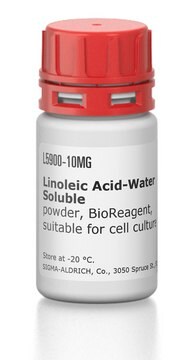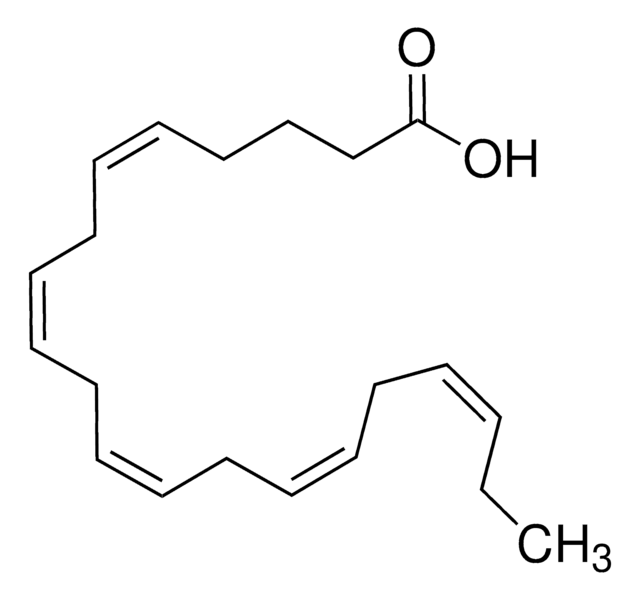L2376
Linolenic acid
≥99%
Sinónimos:
α-Lnn, cis,cis,cis-9,12,15-Octadecatrienoic acid
About This Item
Productos recomendados
Análisis
≥99%
índice de refracción
n20/D 1.480 (lit.)
bp
230-232 °C/1 mmHg (lit.)
mp
-11 °C (lit.)
densidad
0.914 g/mL at 25 °C (lit.)
tipo de lípido
omega FAs
temp. de almacenamiento
−20°C
cadena SMILES
CC/C=C\C/C=C\C/C=C\CCCCCCCC(O)=O
InChI
1S/C18H30O2/c1-2-3-4-5-6-7-8-9-10-11-12-13-14-15-16-17-18(19)20/h3-4,6-7,9-10H,2,5,8,11-17H2,1H3,(H,19,20)/b4-3-,7-6-,10-9-
Clave InChI
DTOSIQBPPRVQHS-PDBXOOCHSA-N
¿Está buscando productos similares? Visita Guía de comparación de productos
Descripción general
Aplicación
- to assess the total antioxidative activity of serum and bacteria
- in palleroni chamber assay
- to prepare free fatty acid mixture
Acciones bioquímicas o fisiológicas
Envase
Código de clase de almacenamiento
10 - Combustible liquids
Clase de riesgo para el agua (WGK)
WGK 1
Punto de inflamabilidad (°F)
235.4 °F - closed cup
Punto de inflamabilidad (°C)
113 °C - closed cup
Equipo de protección personal
Eyeshields, Gloves
Certificados de análisis (COA)
Busque Certificados de análisis (COA) introduciendo el número de lote del producto. Los números de lote se encuentran en la etiqueta del producto después de las palabras «Lot» o «Batch»
¿Ya tiene este producto?
Encuentre la documentación para los productos que ha comprado recientemente en la Biblioteca de documentos.
Los clientes también vieron
Artículos
Importance and uses of linolenic acid in serum-free eukaryotic, including hybridoma and Chinese Hamster Ovary (CHO) cell, cultures
AEM3-944 | UAT | Prefill feature for related product categories not working
AEM3-944 | UAT | Prefill feature for related product categories not working
The potential for the prevention and treatment of cardiovascular disease through increased dietary intake of omega-3 (w-3) fish oils is not a recent scientific discovery.
Nuestro equipo de científicos tiene experiencia en todas las áreas de investigación: Ciencias de la vida, Ciencia de los materiales, Síntesis química, Cromatografía, Analítica y muchas otras.
Póngase en contacto con el Servicio técnico





